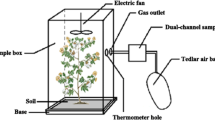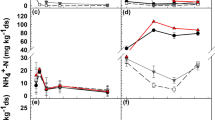Abstract
Investigations about VOSCs (volatile organic sulfur compounds) have been received increasing attention for their significant contribution to the nonvolcanic background sulfate layer in the stratosphere and the earth’s radiation balance and as a potential tool to understand the carbon budget. In this study, COS and CS2 were always recorded throughout the entire rice cultivation season of 2014. COS fluxes appeared as emission in non-planted soil and as uptake in planted soil, the corresponding results were obtained as 2.66 and −2.35 pmol·m−2·s−1, respectively. For CS2, both planted and non-planted paddy fields acted as sources with an emission rate of 1.02 pmol·m−2·s−1 and 2.40 pmol·m−2·s−1, respectively. COS emission or uptake rates showed a distinct seasonal variation, with the highest fluxes at the jointing-booting stage. COS and CS2 fluxes increased with increasing N fertilizer use because of improved plant and microbial growth and activity. Plots treated with both N and S reduced COS and CS2 fluxes slightly compared with plots with only-N treatment. Light, soil moisture or temperature showed no significant correlation with COS and CS2 fluxes, but revealed the important impacts on the magnitude and direction of gases fluxes. The results also showed that the (available) sulfur contents in soil and roots had a certain effect on VOSCs emission or uptake. Our results highlight the significance of biotic and abiotic production and consumption processes existing in the soil.




Similar content being viewed by others
References
Aneja, V.P.: Natural sulfur emissions into the atmosphere. J. Air Waste Manage. Assoc. 40, 469–476 (1990)
Ayotade, K.A.: Kinetics and reactions of hydrogen sulfide in solution of flooded rice soils. Plant Soil 46, 381–385 (1977)
Berry, J., Wolf, A., Campbell, J.E., Baker, I., Blake, N.: A coupled model of the global cycles of carbonyl sulfide and CO2: a possible new window on the carbon cycle. J. Geophys. Res. Biogeosci.118, 842–852 (2013)
Billesbach, D.P., Berry, J.A., Seibt, U., Maseyk, K., Torn, M.S., Fischer, M.L., Abu-Naser, M., Campbell, J.E.: Growing season eddy covariance measurements of carbonyl sulfide and CO2 fluxes: COS and CO2 relationships in southern Great Plains winter wheat. Agric. For. Meteorol. 184, 48–55 (2014)
Bloem, E., Haneklaus, S., Kesselmeier, J., Schnug, E.: Sulfur fertilization and fungal infections affect the exchange of H2S and COS from agricultural crops. J. Agri. Food Chemi. 60, 7588–7596 (2012)
Campbell, J.E., Carmichael, G.R., Chai, T., Mena-Carrasco, M., Tang, Y., Blake, D.R., Blake, N.J., Vay, S.A., Collatz, G.J., Baker, I., Berry, J.A., Montzka, S.A., Sweeney, C., Schnoor, J.L., Stanier, C.O.: Photosynthetic control of atmospheric carbonyl sulfide during the growing season. Science 322, 1085–1088 (2008)
Campbell, J.E., Whelan, M.E., Seibt, U., Smith, S.J., Berry, J.A., Hilton, T.W.: Atmospheric carbonyl sulfide sources from anthropogenic activity: implications for carbon cycle constraints. Geophys. Res. Lett. 42, 3004–3010 (2015)
Charlson, R.J., Rodhe, H.: Factors controlling the acidity of natural rainwater. Nature 295, 683–685 (1982)
Charlson, R.J., Lovelock, J.E., Andreae, M.O., Warren, S.G.: Oceanic phytoplankton, atmospheric sulphur, cloud albedo and climate. Nature 326, 655–662 (1987)
Commane R., Meredith L.K., Baker I.T, Berry J.A., Munger J.W., Montzka S.A, Templer P.H., Juice S.M., Zahniser M.S., Wofsy S.C.: Seasonal fluxes of carbonyl sulfide in a midlatitude forest. PNAS 112, 14162–14167 (2015)
Cui, P., Yao, H., Qi, L.W.: The monitoring of methane concentration in the rice paddy in Beijing. Environ. Sci. 17, 26–28 (1996) (in Chinese, with English abstract)
de Mello, W.Z., Hines, M.E.: Application of static and dynamic enclosures for determining dimethyl sulfide and carbonyl sulfide exchange in Sphagnum Peatlands: implications for the magnitude and direction of flux. J. Geophys. Res. 99, 14601–14607 (1994)
Delaune, R.D., Devai, I., Lindau, C.W.: Flux of reduced sulfur gases along a salinity gradient in Louisiana coastal marshes. Estuar. Coast. Shelf Sci. 54, 1003–1011 (2002)
Devai, I., Delaune, R.D.: Formation of volatile sulfur compounds in salt marsh sediment as influenced by soil redox condition. Org. Geochem. 23, 283–287 (1995)
FAO Quarterly Bulletin and Station. (Vol. 3, pp. 47). http://faostat.fao.org (1990)
Geng, C.M., Mu, Y.J.: Carbonyl sulfide and dimethyl sulfide exchange between lawn and the atmosphere. J. Geophys. Res. 109, 221–236 (2004)
Guo, H., Simpson, I.J., Ding, A.J., Wang, T., Saunders, S.M., Wang, T.J., Cheng, H.R., Barletta, B., Meinardi, S., Blake, D.R., Rowland, F.S.: Carbonyl sulfide, dimethyl sulfide and carbon disulfide in the Pearl River Delta of southern China: impact of anthropogenic and biogenic sources. Atmos. Environ. 44, 3805–3813 (2010)
Hines, M.E., Pelletier, R.E., Crill, P.M.: Emissions of sulfur gases from marine and freshwater wetlands of the Florida Everglades: rates and extrapolation using remote sensing. J. Geophys. Res. 98, 8991–8999 (1993)
Kanda, K.I., Tsuruta, H., Minani, K.: Emission of dimethyl sulfide, carbonyl sulfide and carbon disulfide from paddy fields. Soil Sci. Plant Nutri. 38, 709–716 (1992)
Kelly, D.P., Wood, A.P., Jordan, S.L., Padden, A.N., Gorlenko, V.M., Dubinina, G.A.: Biological production and consumption of gaseous organic sulfur-compounds. Biochem. Soc. Trans. 22, 1011–1015 (1994)
Kitz, F., Gerdel, K., Hammerle, A., Laterza, T., Spielmann, F.M., Wohlfahrt, G.: In situ soil COS exchange of a temperate mountain grassland under simulated drought. Oecologia 183: 851–860 (2017)
Kuhn, U., Ammann, C., Wolf, A., Meixner, F.X., Andreae, M.O., Kesselmeier, J.: Carbonyl sulfide exchange on an ecosystem scale: soil represents a dominant sink for atmospheric COS. Atmos. Environ. 33, 995–1008 (1999)
Lai, X.Q.: The oasis agriculture in China, pp. 3–57. China Agriculture Press, Beijing (2005)
Li, X.H., Liu, J.S., Yang, J.S.: Variation of H2S and COS emission fluxes from Calamagrostis Angustifolia wetlands in Sanjiang plain, Northeast China. Atmos. Environ. 40, 6303–6312 (2006)
Liu, J.F., Mu, Y.J., Geng, C.M., Yu, Y.B., He, H., Zhang, Y.H.: Uptake and conversion of carbonyl sulfide in a lawn soil. Atmos. Environ. 41, 5697–5706 (2007)
Liu, J.F., Geng, C.M., Mu, Y.J., Zhang, Y.H., Xu, Z., Wu, H.: Exchange of carbonyl sulfide (COS) between the atmosphere and various soils in China. Biogeochemi. 7, 753–762 (2010)
Manna, M.C., Swarup, A., Wanjari, R.H., Ravankar, H.N.: Long-term effects of NPK fertiliser and manure on soil fertility and a sorghum-wheat farming system. Aus. J. Exp. Agric. 47, 700–711 (2007)
Maseyk, K., Berry, J.A., Billesbach, D., Campbell, J.E., Torn, M.S., Zahniser, M., Seibt, U.: Sources and sinks of carbonyl sulfide in an agricultural field in the southern Great Plains. PNAS 111, 9064–9069 (2014)
Matthias, A.D., Yarger, D.N., Weinbeck, R.S.: A numerical evaluation of chamber methods for determining gas fluxes. Geophys. Res. Lett. 5, 765–768 (1978)
Melillo, J.M., Steudler, P.A.: The effect of nitrogen fertilization on the COS and CS2 emission from temperature forest soils. J. Atmos. Chem. 9, 411–417 (1989)
Protoschill-Kress, G., Wilhelm, C., Kesselmeler, J.: Consumption of carbonyl sulphide (COS) by higher plant carbonic anhydrase (CA). Atmos. Environ. 30, 3151–3156 (1996)
Rennenberg, H., Polle, A.: Metabolic consequences of atmospheric sulphur in flux into plants. In: Alscher, R.G. (ed.) Plant responses to the gaseous environment, pp. 165–180. Academic Press, San Diego (1994)
Sabit, M., Wang, W.J.: Spatial-temporal variation and protection of wetland resources in Xinjiang. Water Res. Pro. 23, 84–87 (2007) (in Chinese, with English abstract)
Sansum, L.L., Robinson, J.B.D.: Wet digestion, manual and automated analysis of total sulphur in plant material. Commun. Soil. Sci. Plant Anal. 5, 365–383 (1974)
Schäfer, H., Myronova, N., Boden, R.: Microbial degradation of dimethylsulphide and related C1-sulphur compounds: organisms and pathways controlling fluxes of sulphur in the biosphere. J. Exp. Bot. 61(2), 315–334 (2010)
Simmons, J.S., Klemedtsson, L., Hultberg, H., Hines, M.E.: Consumption of atmospheric carbonyl sulfide by coniferous boreal forest soils. J. Geophys. Res. 104, 11569–11576 (1999)
Staubes, R., Georgh, H.W., Ockelmann, G.: Flux of COS, DMS and CS2 from various soils in Germany. Tellus 41B, 305–313 (1989)
Steinbacher, M., Bingemer, H.G., Schmidt, U.: Measurements of the exchange of carbonyl sulfide (COS) and carbon disulfide (CS2) between soil and atmosphere in a spruce forest in central Germany. Atmos. Environ. 38, 6043–6052 (2004)
Stimler, K., Montzka, S.A., Berry, J.A., Rudich, Y., Yakir, D.: Relationships between carbonyl sulfide (COS) and CO2 during leaf gas exchange. New Phytol. 186(4), 869–878 (2010)
Watts, S.F.: The mass budgets of carbonyl sulfie, dimethyl sulfide, carbon disulfide and hydrogen sulfide. Atmos. Environ. 34, 761–779 (2000)
Wehr, R., Commane, R., Munger, J. W., McManus, J. B., Nelson, D. D., Zahniser, M. S., Saleska, S. R., Wofsy, S. C.: Dynamics of canopy stomatal conductance, transpiration, and evaporation in a temperate deciduous forest, validated by carbonyl sulfide uptake. Biogeosciences. 14 389–401 (2017). doi:10.5194/bg-14-389-2017
Whelan, M.E., Rhew, R.C.: Carbonyl sulfide produced by abiotic thermal and photodegradation of soil organic matter from wheat field substrate. J. Geophys. Res. 120, 54–62 (2015b)
Whelan, M.E., Rhew, R.C.: Reduced sulfur trace gas exchange between a seasonally dry grassland and the atmosphere. Biogeochemi. 128(3), 267–280 (2016)
Whelan, M.E., Dong-Ha, M., Rhew, R.C.: Salt marsh vegetation as a carbonyl sulfide (COS) source to the atmosphere. Atmos. Environ. 73, 131–137 (2013)
Whelan, M.E., Hilton, T.W., Berry, J.A., Berkelhammer, M., Desai, A.R., Campbell, J.E.: Carbonyl sulfide exchange in soils for better estimates of ecosystem carbon uptake. Atmos. Chem. Phys. Discuss. 15, 21095–21132 (2015a)
Xu, D.Q., Shen, Y.G.: Diurnal variations in the photosynthetic efficiency in plants. Acta Phys. Sin. 23, 410–416 (1997)
Xu, X., Bingemer, H.G., Schmidt, U.: The flux of carbonyl sulfide and carbon disulfide between the atmosphere and a spruce forest. Atmos. Chem. Phys. 2, 171–181 (2002)
Yagi, K., Tsuruta, H., Kanda, K., Minami, K.: Effect of water management on methane emission from a Japanese rice paddy field: automated methane monitoring. Glob. Biogeochem. Cycles 10, 255–267 (1996)
Yi, Z.G., Wang, X.M.: Carbonyl sulfide and dimethyl sulfide fluxes in an urban lawn and adjacent bare soil in Guangzhou. Chin. J. Environ. Sci. 23, 784–789 (2011)
Yi, Z.G., Wang, X.M., Sheng, G.: Exchange of carbonyl sulfide (OCS) and dimethyl sulfide (DMS) between rice paddy fields and the atmosphere in subtropical China. Agric. Ecosyst. Environ. 123, 116–124 (2008)
Yi, Z.G., Zheng, L.L., Wu, T., Wang, X.M.: Contribution of aboveground plants, the rhizosphere and root-free-soils to total COS and DMS fluxes at three key growth stages in rice paddies. Agric. Ecosyst. Environ. 179, 11–17 (2013)
Acknowledgements
This research was supported by The National Natural Science Foundation of China (No. 41263004).
Author information
Authors and Affiliations
Corresponding author
Rights and permissions
About this article
Cite this article
Jing, W.W., Li, N., Li, X.F. et al. Exchange fluxes of VOSCs between rice paddy fields and the atmosphere in the oasis of arid area in Xinjiang, China. J Atmos Chem 75, 17–32 (2018). https://doi.org/10.1007/s10874-017-9360-1
Received:
Accepted:
Published:
Issue Date:
DOI: https://doi.org/10.1007/s10874-017-9360-1




